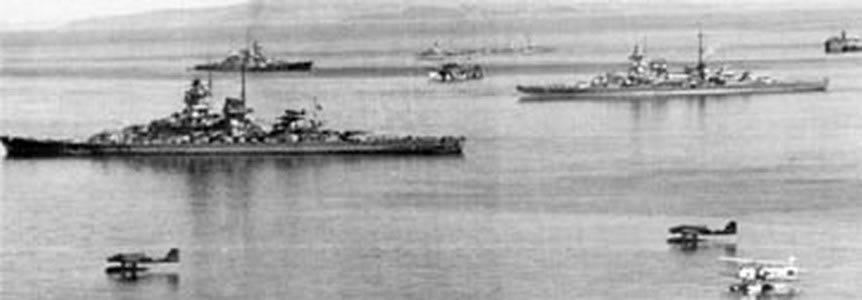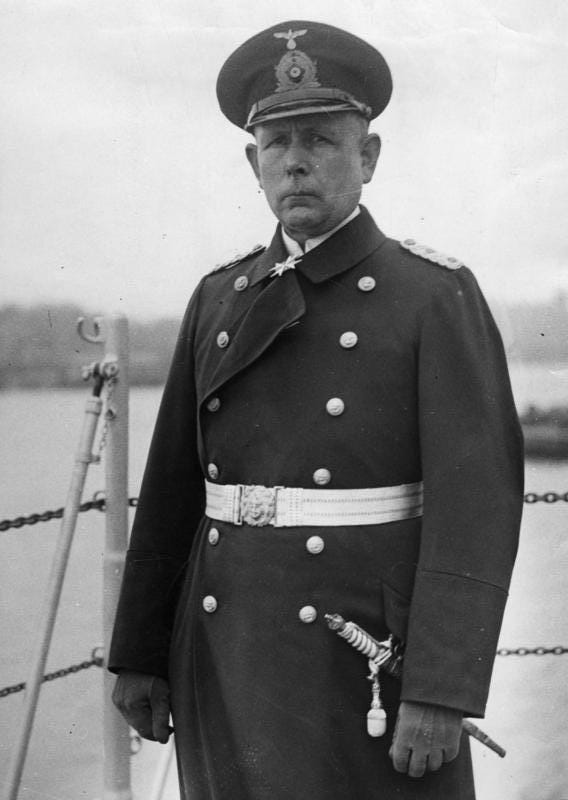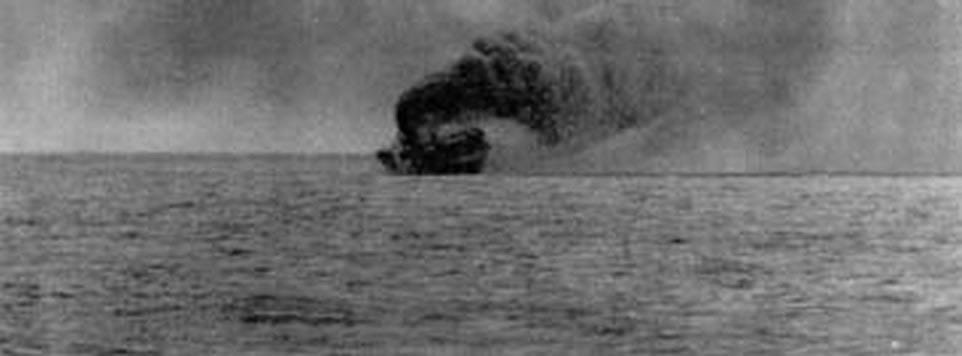I thought I would release my old article on Operation Juno for the anniversary of the loss of HMS Glorious on the 8th June but as I needed a paid article for that day and this one has been around for several years if felt unfair to put it behind the paywall so I’ve left it a couple of days and let everyone enjoy it.
The early months of the Second World War were almost overwhelmingly successful for Germany’s armed forces, but for the Kriegsmarine during the spring 1940 invasion of Norway it was a case of loss, failure and spectacular success.
When the German invasion of Norway, Operation Weserübung, was launched on 9 April, it was initially successful for the air and land forces - the Luftwaffe being able to attain an air bridge to Stavanger on the first day and to limit RAF involvement, whilst the German army battled through the rugged Norwegian terrain. For the Kriegsmarine, however, it had been a rather mixed bag of results.
The heavy cruiser Blücher was sunk in the early hours of the first day by a combination of shore-based gun and torpedo batteries at Oscarsborg, with the light cruiser Karlsruhe torpedoed by a British submarine, HMS Truant, and scuttled by her crew. Meanwhile, her sister ship, Königsberg, suffered severe damage from shore batteries whilst she was landing troops, forcing her to make for Bergen for repairs. By the second day of the invasion, Königsberg had been bombed ineffectually by the RAF, and then successfully by FAA Skua dive bombers operating from the Orkney Islands. The Skua attack left her to capsize and then sink at her moorings. But if these losses in irreplaceable capital ships were not bad enough, then the loss of vital destroyers in Narvik harbour would have a knock-on effect on German naval planning for the next few months.
Damaged by Heavy Fire
On 9 April, ten German destroyers moved into the fjords of Narvik and engaged and sank the Norwegian coastal defence ships Eidsvold and Norge before landing infantry to secure the port and its important military depot. Although victorious, Kommodore Bonte was faced with the problem that just one of his oilers was present in the harbour; Jan Wellem was only capable of very slowly refuelling two vessels at a time. The other vessel, Kattegat, had been intercepted and sunk whilst en-route to Narvik, whilst a second, Skagerrak, was rerouted to join him but would not arrive until 14 April. By the early hours of 10 April, three of the destroyers were refuelled, two were refuelling and a third, the picket ship Diether von Roeder, had left its position and was heading to refuel. But, at 04:30, five Royal Navy destroyers slipped through the hole in the defences and in the ensuing action sank Bonte’s flagship, Wilhelm Heidkamp and the Anton Schmitt, as well as eleven merchant ships in the harbour, for the loss of two of their own number.
Fregattenkapitan Erich Bey took command of the flotilla but was faced with damaged vessels and shortages of fuel and ammunition. The following day, Vice Admiral Whitworth arrived aboard HMS Warspite, accompanied by ten destroyers and the aircraft carrier HMS Furious. In the ensuing action, Bey’s command was either destroyed or scuttled, and shore facilities were damaged by heavy fire. With the loss of these ten destroyers, the Kriegsmarine lost half of their overall destroyer strength. This devastating loss would restrict all further capital ship operations as there were now inadequate screening vessels for protection.
Reconnaissance-in-Force
Compounding the defeat of the destroyer flotillas was the fact that General Dietl’s Gebirgsjägers were now cut off with no hope of reinforcement within Narvik, where British and French forces were now landing to take the port under the watchful guns of Warspite.
The only hope was to rush reinforcements to Dietl, with Hitler proposing the sending of two liners at full speed up the coast. Despite Raeder’s support, Admiral Saalwachter, the commander of Marine-Gruppenkommando West, was lukewarm about this proposal believing it would be a waste of two perfectly good liners and he quietly buried it. A reconnaissance-in-force, led by Admiral
Marschall with the battleships Scharnhorst and Gneisenau, and escorted by the heavy cruiser Hipper and four destroyers, would depart as soon as the two battleships had been repaired of damage sustained during the invasion. Marschall’s orders were to avoid docking at Trondheim for security reasons, and instead to push up to Narvik and destroy the British base at Harstad, as well as enemy shipping in the surrounding fjords. They sailed at 07:00 on 4 June for what was scheduled to be Operation Juno.
‘Like Beating the Air’
On the night of 6 June, having reached their target latitude, Marschall called a conference with his Captains, his chief of staff, Konteradmiral Backenköhler, together with Konteradmiral Schmundt of the reconnaissance forces and Kommodore Bey commanding the destroyer force. Marschall outlined that he was unhappy about leading his ships into the confined fjords without adequate reconnaissance or any knowledge of their defences, including the status of mines, torpedo barrages, nets and enemy destroyers. The speed and armament of his battleships were their advantage, but the fjords would rob them of this. He was also unwilling to lose Germany’s only two battleships in the same way the Blucher had been lost and was of the opinion they had more to gain by instead disrupting British shipping and naval forces.
A report from the Arado seaplane pilots based on Scharnhorst and Gneisenau detailed that a heavily escorted convoy was sailing west, and away from Norway. For Marschall, it became clear that the Allies were departing Narvik – a fact made even more logical considering that the Wehrmacht had smashed the French and British armies in France and the BEF had been completing their withdrawal from Dunkirk. He wrote in his diary that:
“This surprising westward movement may mean the British are evacuating Norway... an attack on Harstad would be like beating the air.”
It was a decision that was not backed by Gruppenkommando West who sent an urgent telegram at 05:00 the next morning saying that Marschall had not provided adequate reasons for his decisions, and insisted that they should press on to Harstad in accord with the objectives of Juno. But it was too late. Marschall had already dispersed his fleet to search for convoys.
Rules of War
That morning, Hipper chased down and sank the empty tanker SS Oil Pioneer whilst the escorting armed trawler, Juniper, signalled the Gneisenau requesting her identification. The reply was: “HMS Southampton“. This cheeky retort was followed immediately by a salvo of 28 cm shells. Not long afterwards, the empty liner SS Orama, which was to have been used as a troop transport, arrived on the scene and was likewise dispatched by Hipper. While the Germans picked up 268 survivors from the freezing ocean, the hospital ship HMHS Atlantis arrived. The rules of war at sea dictated that hospital ships were not to be fired on, and this was the practice observed by Marschall’s forces whilst, reciprocally, the Atlantis observed the rule that it couldn’t communicate the German’s position by wireless. Consequently, news of the German flotilla’s actions was not communicated to the Royal Navy until Atlantis met with HMS Valiant the following day.
Marschall, meanwhile, was not happy about having his ships refuel at sea fearing that they were too vulnerable and that it would take far too long, and so he agreed that the Hipper and the destroyers should return to Trondheim for refuelling whilst he took the battleships off to scout out enemy vessels, again ignoring fresh orders from Gruppenkommando West to proceed to Halsted immediately.
Several hours later, in the crow's nest of Scharnhorst, midshipman Goos scanned the horizon
looking for ships of the promised convoys. The sky was clear, and vision was excellent at up to just over 27 miles. At 15:45, Goos spotted a thin sliver of smoke on the horizon and brought the powerful range finders round to bear on it. Almost immediately, he was able to define masts as well.
Marschall, on the bridge of Gneisenau, received a signal from Scharnhorst‘s captain, Kurt Hoffman, that vessels had been spotted and that Scharnhorst would move to investigate. As the Gneisenau fell into line behind her sister, who was increasing speed, Marschall was warned that maybe they were approaching battleships and caution was urged. Marschall responded with a shrug and replied: "We shall attack all the same."
A Remarkable First Salvo
As Scharnhorst approached her foe, the Chief gunnery officer, Fregattenkapitan Wolf Lowisch, contacted Hoffman from his post in the foretop to report that the vessel had a "thick funnel and mast with turret, probably also a flight deck." He concluded that the ship was most likely HMS Ark Royal. The enemy vessel seemed to be aware of the two German ships, despite not having the usual defensive flight of aircraft above. The carrier then began to steer away, but at 16:32 Hoffman gave Lowisch the order to open fire, the two forward turrets firing at maximum elevation and at a range of 16 miles - the ship’s ‘Anton’ turret firing a second salvo within ten seconds of firing the first.
Aboard the fleeing British aircraft carrier, HMS Glorious, were the ship’s embarked naval air squadrons with the Gladiators of 263 Squadron and Hurricanes of 46 Squadron, both units being evacuated from Norway. Squadron leader Kenneth Cross of 46 Squadron stood on the flight deck looking at the distant smoke of the approaching German vessels:
"As I looked at them, I saw flashes. In a few seconds, plumes of water came up just a few yards from where we were standing. It was, considering the Germans were virtually out of sight - all you could see was the smoke - a remarkable first salvo."
Within six minutes of firing the first salvo, the first strikes hit Glorious, penetrating her flight deck and starting a fire that set light to 46 Squadron’s Hurricanes and blocking access to the torpedo magazines, meaning that the carrier's Fairey Swordfish aircraft could not be armed.
Country’s Gold Reserve
The first successful salvo also knocked out the vessel's wireless transmitters, and only a garbled message requesting assistance and confirming that Glorious was under attack was sent through the auxiliary transmitter before Gneisenau's wireless officers may have jammed transmissions. Eighty miles away, HMS Devonshire received the message but was reportedly unable to ascertain what it was about – although that version of events has since been challenged. In any event, Devonshire was unable to assist because the cruiser was carrying the Norwegian King and the country's gold reserve to Britain. Another salvo then struck the bridge, killing Captain D’Oyly-Hughes and many of the bridge crew, leaving the First Officer to give the order: “Report to abandon-ship stations!”
HMS Ardent and Acasta, the two escorting destroyers, had not been sitting idly by during the opening of combat and began laying a smoke screen to shield Glorious from view whilst engaging the German ships with their relatively small 4.7” guns. In turn, they were engaged by the two German vessel’s secondary guns (15 cm). Ardent then made torpedo runs out of the smoke screen, despite taking damage early-on in the engagement which hit her boiler room. Meanwhile, Acasta tried to further support the Glorious.
The smoke screen was so effective that by 16:58, Glorious could not be seen and the German vessels switched their fire to Ardent whenever she appeared through the smoke. Finally, at 17:00,
the destroyer was hit repeatedly, lost speed and eventually caught fire. After firing one last torpedo, she capsized and sank.
Under Heavy Fire
As the smoke began to clear around the stricken Glorious, the Germans resumed fire and the ship began to list under the weight of exploding shells before the main engine room was fatally struck. As the ship slowed, the crew tried to escape on any boats that could be freed, as well as on Carley Floats, while Scharnhorst and Gneisenau closed in for the kill.
Undeterred by the heavier German leviathans, Commander Glasford on Acasta announced to his crew that:
“Our chummy ship has sunk, the Glorious is sinking; the least we can do is make a show. Good luck to you all!”
The Acasta then burst forward, firing off torpedoes at Scharnhorst and under heavy fire as both German ships had already abandoned Glorious to her fate. As the torpedoes shot invisibly towards Scharnhorst, Hoffman ordered his vessel to change course for three minutes and to then veer back on an intercept course, but it was too late. Acasta’s last torpedo struck the warship beneath her ‘Caesar’ turret, causing flooding in the gun’s magazine and taking it out of action. Leading Seaman Carter, the sole survivor of Acasta, recalled: “I’ll never forget the cheer that went up. On the port bow of one of the ships, a yellow flash and a great column of smoke and water shot up from her. We knew we had hit.” Moments later, Acasta was gone.
The German crew were elated, the battle having been captured by the cameras of a Wochenshcau newsreel team to show to a jubilant civilian population, with one officer recalling the Glorious’ sinking:
“The glow of fire was to be seen in the Glorious. Slowly, the giant began to turn on her side. Pouring out flames and smoke, she drifted with the wind. A moment later she sank.”
A Devastating Blow
For the British servicemen now in the freezing cold water, there would be no rescue and capture by Marschall’s ships. The Admiral knew the first lesson of a successful raider was to not be caught out, and he gambled that the British would quickly come looking for their missing carrier. It would be unwise for his ships to be there when they did! On top of that, Hoffman reported that the torpedo that had struck Scharnhorst must have come from a submarine because they had not seen any tracks in the water. Marschall was thus not willing to further risk his vessels. With the Scharnhorst taking on 2,500 tons of water, her speed reduced to 20 knots and with the ‘Caesar’ turret still out of action, the only possible course of action left to Marschall was to order his two battleships to return to Trondheim, rather than press on and run any further risk.
These early naval encounters of the Second World War in the cold waters around Norway had been costly for both sides, but the loss of HMS Glorious, along with all her aircraft and most of her crew and the embarked RAF and FAA pilots, had been a devastating blow to the British. In total, some 1,519 men were lost in an event which remains controversial in Britain to this day. It was also an event which demonstrated the potency, at that time, of Germany’s Kriegsmarine.
I’ve also done an interview for WW2TV on youtube so if you fancy a watch here it is!





An aircraft carrier?! Was there a “protocol” of protection. Notwithstanding the “energy” of the German commander to pursue the “convoy” on the basis of his aircraft reports of an “empty” Narvik” ?